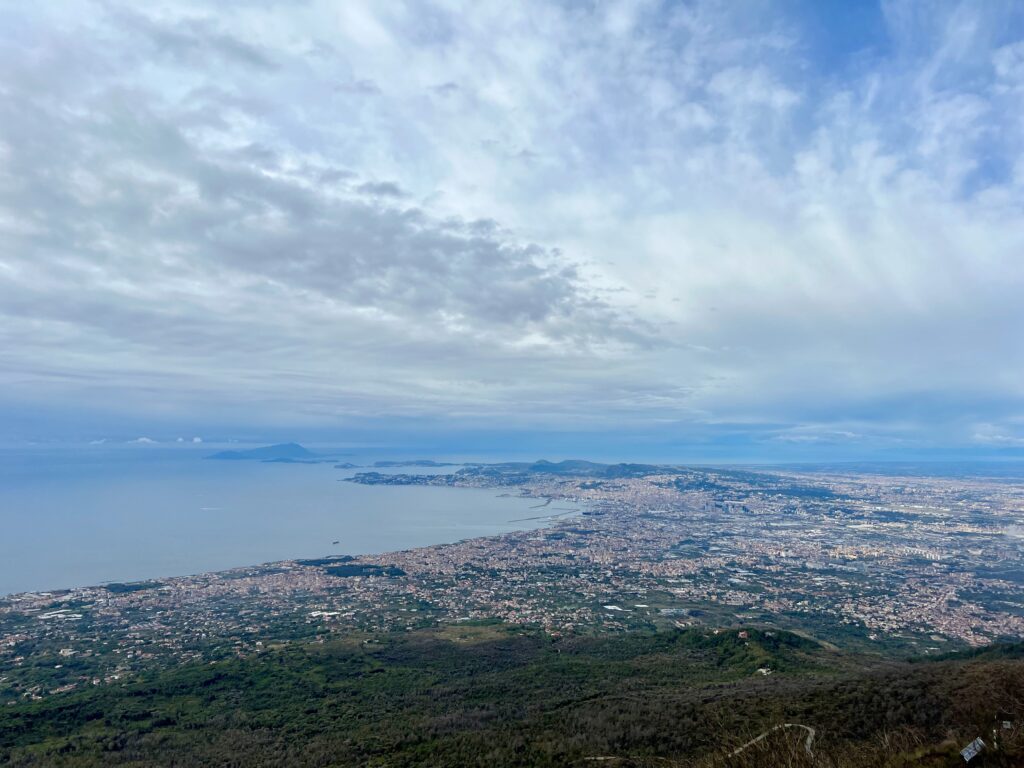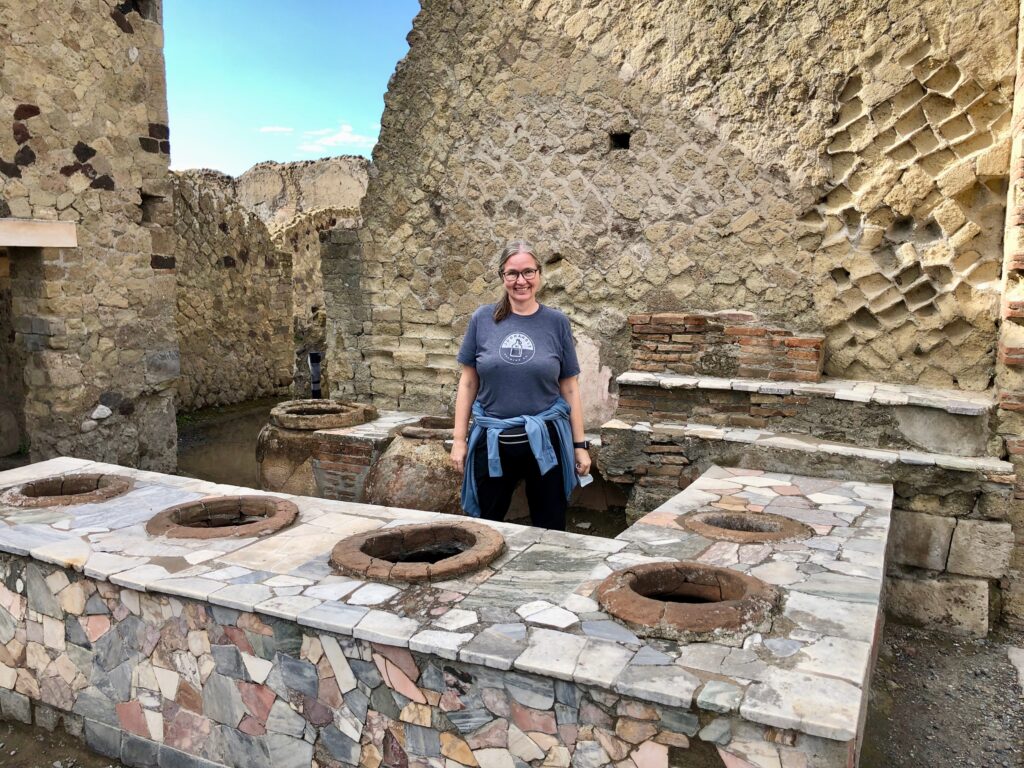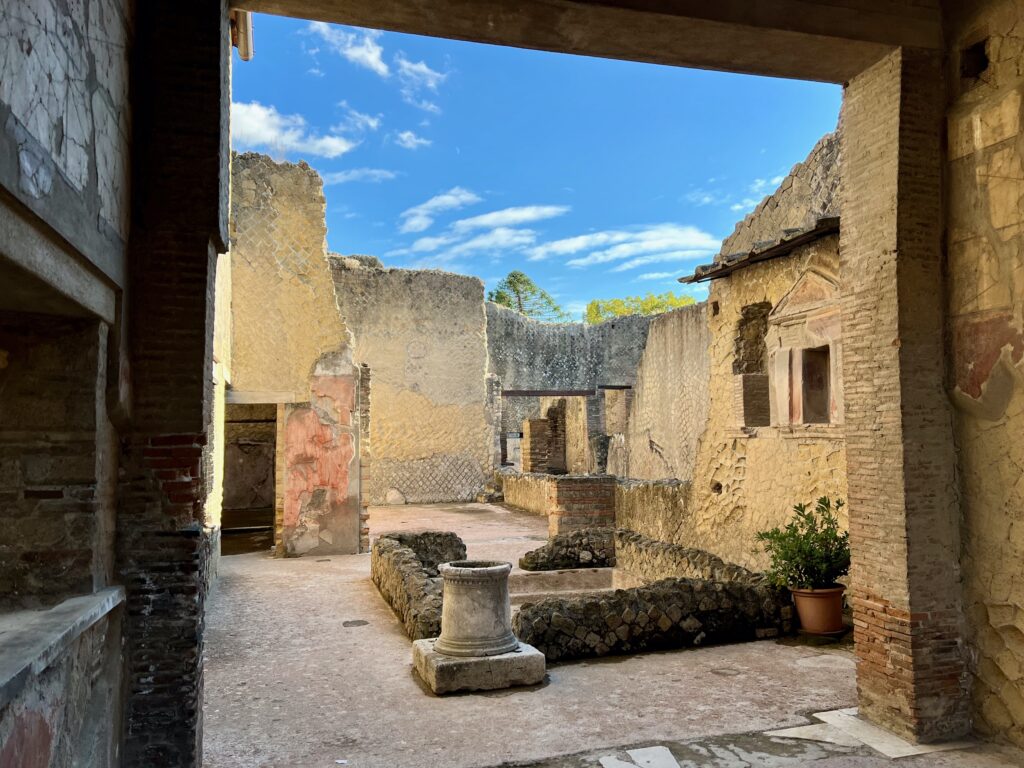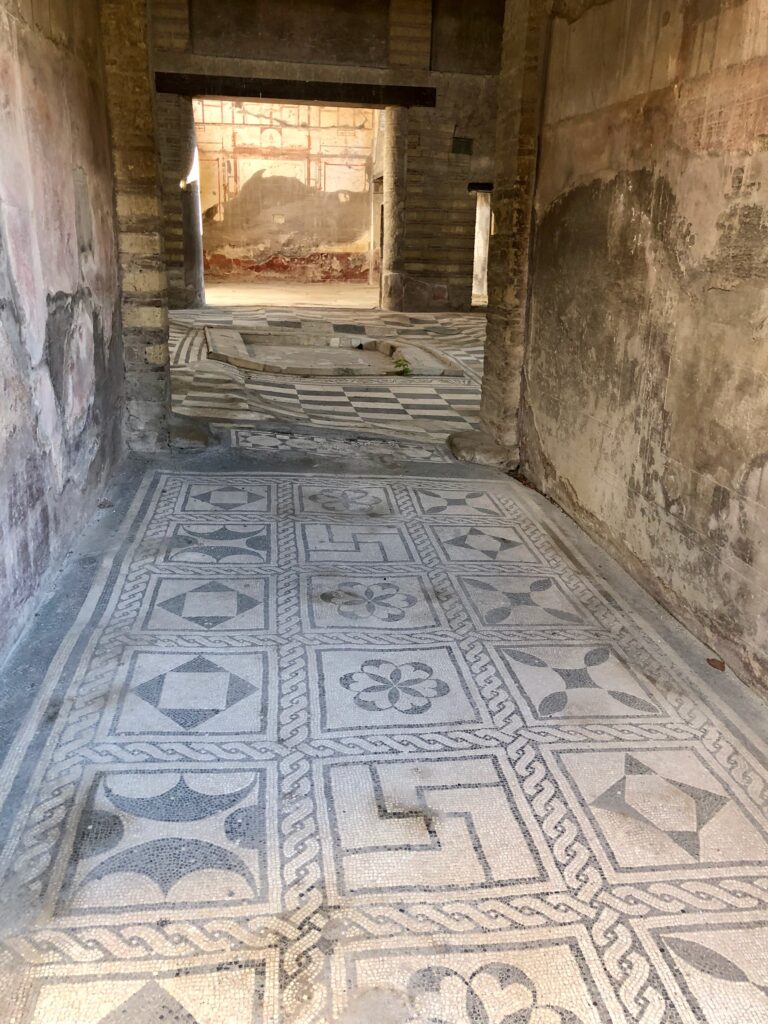Hiking the Mount Vesuvius Cone Loop + Visiting Pompeii and Herculaneum from Naples, Italy

Pompeii 
Herculaneum 
Vesuvius
Over the October school break, we took the train to Naples, Italy. There, in addition to eating lots of pizza, we visited Pompeii and Herculaneum (two ancient cities buried by the eruption of Mount Vesuvius in AD 79) and hiked the Cone Loop at Mount Vesuvius. To give us the time we wanted to visit each of these sites, we did this as a two-day itinerary – Pompeii on day one, and Vesuvius and Herculaneum on day two, and we visited these sites on our own (without a tour) using public transportation. Below I cover our experience along with some notes on logistics that I want to keep handy should I plan future trips here.
Detail Summary| What: | 2-day Itinerary from Naples, Italy Day 1: Visiting Pompeii Archeological Site Day 2: Hiking the Mount Vesuvius Cone Loop and Visiting Herculaneum Archeological Site |
| Train/Bus: | Pompeii: Naples -> Pompeii Scavii – 40 minutes + 5 minute walk to site Herculaneum: Naples -> Ercolano – 20 minutes + 10 minute walk to site Vesuvius: Naples -> Ercolano – 20 minutes + Vesuvio Express Bus (I don’t know how long the bus takes as I did not take it) Note: You can also pay more and take a taxi. |
| Cost 2021 | Train tickets are approximately: EUR 2 Euros each way. Vesuvio Bus: We didn’t take it and I could not find a reliable price online (Saw both EUR 10 and EUR 20) Pompeii entrance tickets: EUR 16, EU citizens under 18 – free Herculaneum entrance tickets: EUR 13, EU citizens under 18 – free Vesuvius entrance tickets: EUR 10 |
Pompeii Archeological Site – official visitor information TicketOne – the official seller for online tickets for Pompeii Visit Pompeii – Comprehensive visitor information and tours for Pompeii, Herculaneum, and Vesuvius including public transportation suggestions and driving routes. Mount Vesuvius Park – Official visitor information and tickets Getting Around Naples: Guide to Public Transportation – a helpful guide to understanding public transportation in Naples, including the Circumvesuviana train line by Tripsavvy. Circumvesuviana – commuter line connecting Naples with Pompeii Scavi (Stop for Pompeii) and Ercolano (Stop for Herculaneum). The train schedule is available on the EAV (Ente Autonomo Volturno) (Italian only) website. National Museum of Archeology in Naples |
Before going, I had seen several tours offering visits to Pompeii, Herculaneum, and Mount Vesuvius all in one day, but I am glad I didn’t do that as I think it would have been too aggressive. To give you an idea of how much walking there is to do, according to my Apple watch we did over 25,000 steps each day visiting these three sites. Most importantly, I don’t think it would have allowed enough time to properly see Pompeii. On the other hand, a tour would have handled all the transportation and that might have been worth it as the trains were on strike one of the days we were there.
Visiting Pompeii
On our first day, we visited the Pompeii archeological site – the excavated remains of the ancient city of Pompeii which was buried by 6 meters of ash and rocks during the eruption of Mount Vesuvius in AD 79. At the time of its destruction, Pompeii covered a total of 160 to 170 acres (a good portion of which is now excavated and can be walked) and was home to approximately 11,000 people. The preservation and scale of the site is absolutely amazing and we could really sense what it must have been like to live here 2000 years ago.
Buying Tickets and Getting There
To visit the Pompeii archeological site, we purchased tickets ahead of time online through TicketOne (the official seller). Tickets have a timed entry and we purchased a 10:00 am entry time. Tickets can be purchased at the gate on site, but do sell out.
To get to Pompeii, we took the Circumvesuviana train from Garibaldi station in Naples to the Pompeii Scavi station where the entrance to the Pompeii Archeological site is located. The Circumvesuviana train line is a commuter line run by EAV (Ente Autonomo Volturno) (Italian only). In Naples, you can catch this train either at the Porta Nolana station (many people recommend this as it is the first station and the train is often crowded. Getting on at Porta Nolana makes it more likely you will get a seat), or you can do as we did and get on at Garibaldi station (the main train station) and stand for the entire trip. In Garibaldi station, to find our train, we simply followed the “Circumvesuviana” signs to the Circumvesuviana ticket booth and platforms. The signs for the ticket booth use the operating company name “EAV”. We had to ask at the booth to know we were in the right place. After getting our tickets, we walked across the hall towards the trains. There, we validated our tickets (ran them through the machine on the wall to have the date/time stamped on the back) and then headed down to our platform to wait for our train.
The train schedule is online, and it says the normal trains take about 40 minutes to get from Garibaldi station to the Pompeii Scavi station. (Note: If you plan to take an express train, say so at the ticket booth as express trains use a different ticket and cost more.) We had heard that the trains often run late, so we planned to take a train getting us to Pompeii Scavi about a half hour ahead of our scheduled entry time. It was a good thing we did, as our train left the station about 20 minutes behind schedule.
When we arrived at the Pompeii Scavi station, it was just a short walk to the Pompeii Archeological site. After showing our Covid Certificates (Green Pass) and tickets, we were inside and walking on history.
Touring the Site
You can purchase an audio guide at the gate, but we decided we would rather just wander around. We tried to use the MyPompeii app to orient ourselves but I have to give the app 0 stars as it was totally unhelpful. We ended up using Google Maps to keep from getting lost and to make sure we weren’t walking in circles. Even without a guide, walking around Pompeii was incredibly fascinating. Strolling through the streets of Pompeii and walking among the building foundations provided an incredible perspective on life 2000 years ago.
We walked through courtyards, homes, fast food stalls, bakeries, shops, theaters, and even a brothel!
The artwork, especially the mosaics, were incredible. Even the graffiti was interesting. While some of the best mosaics and paintings found here have been moved to the National Museum of Archeology in Naples, there were still some very impressive ones on site. (We visited the museum later in the week, and I recommend it.)
Walking around Pompeii, it was easy to imagine what a bustling, thriving, artistic city it must have been and to begin to understand what a tragic apocalypse the eruption was. It is estimated that at the time of its destruction Pompeii was home to about 11,000 people. There were several areas that noted where human skeletal remains were found, but, one of the more fascinating/creepy things about Pompeii is that the volcanic ash has allowed for a more intimate look at some of the victims. The layer of ash that fell on Pompeii after the eruption preserved the form of some of the victims’ bodies and in 1863, a man named Giuseppe Fiorelli created a process to make casts of these preserved forms.
After wandering the park for almost 5 hours, we decided it was time to head back to our hotel. If you plan to go to Pompeii, I strongly recommend wearing good walking shoes. There is simply a lot of walking to do to see as much of the site as you can. It also rained while we were there and the stone paths got rather slippery, making good shoes a must. Another good idea? Bring water and snacks with you (which we did) and pack a lunch, too (if you don’t want to get overpriced sandwiches from the cafe like we did).
Getting Back to Naples
After exiting Pompeii Archeological park, it was just a short walk back to the Pompeii Scavi station. After almost forgetting to validate our tickets, we caught the next train back to Naples.
Hiking the Mount Vesuvius Cone Loop
On the morning of the second day, we hiked the Mount Vesuvius Cone Loop trail. The Cone Loop trail, at roughly 5 km and 150 m up and down, offers spectacular views of Naples and the coast, along with a fabulous view into the cone of the volcano responsible for the destruction of Pompeii and Herculaneum. I am really happy we got to do this hike, even though getting there was a bit complicated.
Getting There and Buying Tickets
My plan had been to take the Circumvesuviana train from Garibaldi station to Ercolano (where Herculaneum is located), and to take the Vesuvio Express bus that can be picked up across the street from the Ercolano station. We also planned to visit Herculaneum afterwards, but things did not go as planned.
Unfortunately, when we arrived at Garibaldi station, we found that the Circumvesuviana trains were not running because of a strike organized to protest the Covid vaccination requirements for public employees. (One of the reasons we chose to visit Italy was that they require proof of vaccination to enter pubic places (restaurants, museums, etc.) which gives at least some measure of safety in this pandemic. So, this strike wasn’t just disappointing because we couldn’t take the train we planned.) Not wanting to give up on this hike, we decided to take a taxi. For EUR 100, the taxi driver would take us up to the ticket office on Vesuvius and then to the trail head. There, he would wait two hours for us to hike the trail and then drive us back to Garibaldi station. (The brochure the taxi driver showed us had similar deals for other sites, such as Pompeii.)
Once we were on our way, we should have purchased tickets online, as the ticket office was closed when we got to it and we needed to purchase tickets online anyway. But, as there wasn’t service at the trail head, we had to pay a surcharge to use someone’s internet connection to buy the entrance tickets, thus effectively doubling the expected entrance cost for us. Lesson learned. So, while it all ended up being more expensive than I planned, we had our tickets and we were ready to hit the trail.
Hiking the Trail
Although it is called the Cone Loop trail, the trail is not a loop – it is a there-and-back again trail. The first kilometer of the trail takes you from the park entrance up 150 m of elevation gain to the rim of the cone.
When you reach the rim, there is another kilometer and half or so along the rim. From here, there are fantastic views both into the cone of the volcano and out across the bay.
At the end of the trail, there was a small kiosk selling drinks and snacks. From there, we simply turned around and retraced our steps back to the start of the trail.
Getting Back to Naples
When we reached the parking lot, our taxi driver was waiting there to take us back to Naples. We tried asking the driver to drop us off at Ercolano station rather than return us to Garibaldi station so we could visit Herculaneum, but between our non-existent Italian and our driver’s limited English we could not make our intentions clear. In the end, we just went back to Garibaldi station. Luckily, the train strike had ended by the time we returned and we were able to continue with our original itinerary and visit Herculaneum in the afternoon.
Visiting Herculaneum
The afternoon of our second day, we visited the Herculaneum archeological site – the excavated remains of the ancient town of Herculaneum. Like Pompeii, Herculaneum was buried during the eruption of Mount Vesuvius in AD 79. It is a much smaller site than Pompeii, but because it was buried more deeply in ash and hit by fewer rocks, it is much better preserved. Some of the two story houses have their original roofs and even some of the charred original wood remains.
Getting There and Buying Tickets
To get to Herculaneum, we took the Circumvesuviana train from Garibaldi station to Ercolano. From there, we followed the signs to Herculaneum (about a 10 minute walk). We had not purchased tickets online ahead of time so we purchased our tickets at the gate. This was a weekday in October, so there wasn’t much of a line.
Touring the Site
After getting our tickets, we walked down to the entrance, showed our Covid Certificates and tickets and began to explore. Again, we chose to just wander around rather than do an organized tour. Herculaneum is fairly small and you can easily see all of it in a few hours. You can see almost the entire site in the first overview picture below. In the second picture is a stark reminder that is was an apocalypse. Inside each of the boat docks are skeletons marking where human remains were found. It is believed the residents of Herculaneum fled here to escape the flying rocks and debris, but tragically there was no escape from the intense heat.
Despite the grim reminder that we were walking on an apocalypse, it was really interesting to get a more complete view of what the houses and shops were like at the time. In the third picture below, I am standing behind what would have been a food stand. (Pompeii had many of these stands as well, but this was the best picture we got from either location.) The two story houses on the street in the third picture seemed so much more modern than their actual age of 2000 years.
Like Pompeii, Herculaneum had some extraordinary art work and mosaics.
One of the most interesting things about Herculaneum was that some of the original wood had been preserved. In the first picture you can see the charred remains of a wood gate (now behind protective glass) and a modern day reproduction of that gate along side. In the second picture is the charred remains of bed.
After about 2 hours, we think we had walked every street in Herculaneum and entered every open building. All of it was fascinating and getting to see details, like the charred wooden gate, that hadn’t survived at Pompeii made it worth coming to Herculaneum.
Getting Back to Naples
After exiting Herculaneum, it was just a short walk back to the Ercolano station where we caught the next train back to Naples.
This was a great two days in Naples!










































Leave a Reply